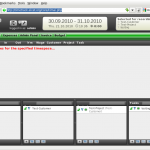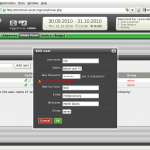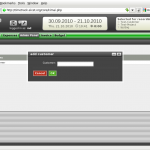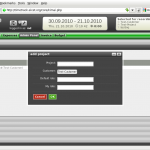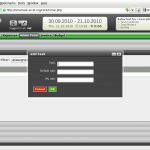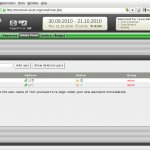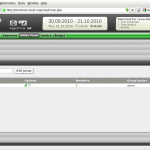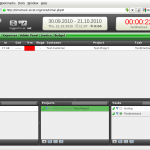Today, in the business area: Time tracking. Kimai.
The Kimai project originated from Germany, which is also evident in some of the default values you encounter along the way - but to comment on first glance: You are asked whether you prefer an installation in English or in German.
There are several aspects of time tracking. On one hand, there is measuring the time - how much time has been spent on what; second, there is how much time it has taken to work on a specific task, perhaps as part of a larger project. Maybe there are more people we need to track, but they still may work on the same project. And maybe this is one of several projects associated with a client we would like to wrest some money out of.
Kimai is a web client allowing individual users to log in. You select a customer and a project - and a task to track time for.
There are two ways of doing this.
One way is to simply use this as a notepad for time you have already registered - and a calculator to report on how much has been registered so you know how much to squeeze the client for.
The other is to push the huge green button on the interface - and it will start a stop watch. Now, doing that like this is clever; it is tied to a web-based system. That means that if you need to use another computer to do this work - or the copier, fax, scanner or hangglider - the clock will keep ticking, and once you come back, you can log in and stop the clock. It will register the hours you have spent on the task. This also means that if you have to do client services while on vacation by the hot, sandy beach, you can still go to your local internet café, log in, start your timer, help out your client, quit it - and your home accountant can log in to collect the cash from the client, and your colleagues can log in to see what has been done on the job.
Now, your home accountant doesn’t have to go that far to collect, because Kimai will create a timetrack report, and even an invoice for the client. Kimai doesn’t really do accounting, so it is simply a question of converting the relevant billable time to an invoice, and your accounting system - and we will be covering the very promising Phreebooks soon - will do the rest.
There is one issue we have come across, and a potential feature - both of which have been taken up in the development forums: First, there is a bit of confusion when you are in a different timezone from your Kimai installation, because while the installation will show local time in the interface, it will use server time in the tracked time and report. And while this will not change the time spent, it may place billable time on a different date from what you - and, more importantly, your client - has experienced. This is a real issue in a world where your system hosting is not necessarily on the same continent as you - and with a company spanning many time zones, this would be an issue. After addressing this on the forums, it seems that it is a recurring request - and a fix has been committed to be included in the upcoming release. As a completely web-based operation, we have submitted a feature suggestion: That since this system is tied into the user, it might be practical to associate a per-user time zone. Consider a law firm with a branch in New York, Houston and San Francisco. In this case, it would be useful for every Kimai user to have an associated time zone. Also, it is possible to create groups for users, and a suggestion for this issue could be to create a group for varying offices; of course, this would require multiple-group membership as an option, since one would still need to be in the accountant group, even if registered as part of the Houston group.
From the category of not-too-serious-but-nice-to-have, it should be mentioned that when you create a customer, there are no additional fields beside the customer’s name/identifier. We have submitted a feature request to make it possible to add more info on the clients in order to make it a lightweight CRM, partly because of the invoice feature.
Kimai will not let you work on the same project for several clients. While we will agree that this is not the most obvious combination, it has been done in situations where a cooperation agreement is place, and various clients will pay for different aspects of a project. Of course, this is something one can work around. This is not a project management system, but a time tracker with integrated reporting and invoicing.
- First page of the installer allows you to choose the language for the installer. Note that the interface language can be selected later.
- Verifying the server features.
- Installation is done. You can now login with the default login.
- On first login. This indicates which user, customer and project to track time for, and which tasks are being performed. Here, one can add time by pressing the + button in the upper left of the table - or start tracking time by pressing the great, green clock.
- The default user is “Admin” with the password “changeme”. One should take that seriously.
- This allows you to create a new customer. Note that there are no CRM features associated with this - just an identifier. This, however, is a feature in the pipes, to be associated with the invoicing as well.
- The projects are added under the customer. It is not possible to associate more customers with one project, but one can create projects with similar names for each customer, if need be. Note this is where the rate is set, if different from standard.
- It is assumed that it is the same kind of tasks you will be performing for several clients, so if you add the kind of services you expect to provide, these are always available.
- The place where you have an overview of your users, their active/passive status and group.
- The group administration interface. Currently, this does not seem to do anything beside allowing you to group people for your own overview.
- A timetrack as been started. Note that the large green clock has become read, and the timer next to it is counting. Once the clock is pressed again, the accumulated time will be registered for a time track.
- As noted, it is possible to add time manually, if it has been recorded while the user was away from a computer. Here, you also see the note field, which is useful for when you auto-generate an invoice later, and the customer can see what you have done in your billable hours.

